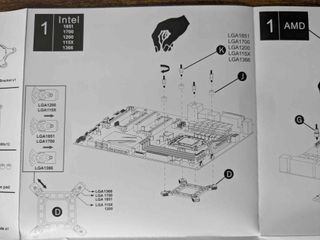
For PC enthusiasts, Azza has unveiled their latest Cube 240 and Cube 360 liquid AIO coolers, engineered to seamlessly support the upcoming LGA1851 socket tailored for Arrow Lake processors. This announcement positions Azza as the second CPU cooling brand, following in the footsteps of industry heavyweight Noctua, to confirm the compatibility of current LGA1700 coolers with the impending socket.
The LGA1851 socket, boasting an impressive 1,851 contacts, marks a notable 9% uptick from its predecessor, the LGA1700 socket. While leaked schematics of the LGA1851 depict identical socket dimensions (45 x 37.55mm) and mounting spacing as the LGA1700, this continuity isn’t surprising given Intel’s longstanding stability in mounting configurations on mainstream platforms.
The standout alteration with the LGA1851 socket appears to be a reported surge in maximum dynamic pressure. Sources suggest that the LGA1815 socket showcases an astounding 89% greater mounting pressure compared to its predecessor, the LGA1700.

The augmenting maximum dynamic pressure value implies heightened mounting pressure from the CPU cooler. However, it’s important to note that this may not be a universal scenario. Noctua, for example, has preemptively affirmed LGA1851 compatibility with its retail CPU coolers, omitting any mention of an auxiliary mounting kit for LGA1851. Similarly, a Reddit thread featuring the user manual for the Azza Cube 360 underscores native LGA1851 support without the requirement for additional accessories.
Shifting focus from the hardware to the performance metrics, the transition from Alder Lake to Raptor Lake brought about no changes in the Processor Boost Power (PBP). However, the Maximum Turbo Power (MTP) has witnessed a substantial surge in specific Stock Keeping Units (SKUs), logically necessitating heightened thermal performance.
For instance, the Core i7-13700K boasts a remarkable 33% higher MTP when compared to its predecessor, the Core i7-12700K. The Core i5-13600K showcases an MTP that is 21% greater than the Core i5-12600K.
Rumored internal projections for Arrow Lake’s performance claim a potential boost of up to 21% over Raptor Lake Refresh, all while operating at 250W. The hope amongst enthusiasts is that Intel adheres to this power range for Arrow Lake. It’s reassuring for users to learn that existing LGA1700 coolers have the potential for continued use with Arrow Lake.
Nevertheless, the effectiveness of this approach remains uncertain. Those equipped with a 360mm or even a 240mm AIO liquid cooler are likely to face minimal concerns. In contrast, owners of budget-friendly $50 CPU air coolers may need to reconsider their options if pairing with a high-end SKU is in the cards.
Looking ahead, the LGA1851 socket is projected to remain relevant until 2026. Following Intel’s established cadence, this timeline is expected to encompass two generations of processors, commencing with Arrow Lake and culminating with Lunar Lake. The possibility of a refresh hinges on the competitiveness of AMD’s Zen 5 and potential challenges Intel may face in subsequent architectural developments.
This news marks a welcome development for users invested in Intel’s ecosystem. With the assurance that proficient Intel CPU coolers may continue their service for the next three years, provided they opt to retain their cooler while upgrading other components of their PC, including the motherboard and CPU, the transition to Arrow Lake holds exciting prospects for the PC enthusiast community.
Related:
Liquid Metal Air Cooler Dubbed ‘Most Dangerous Cooler Ever Made







